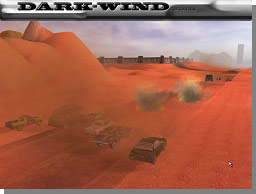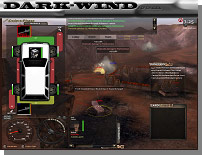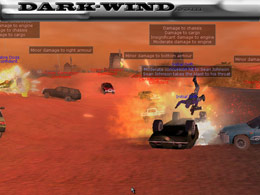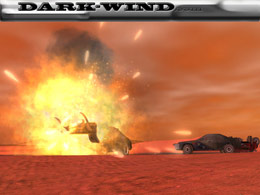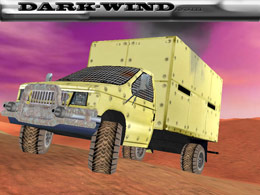
Darkwind: War on Wheels - Computer Controlled Cars learn from player behaviour and evolve through the use of Genetic Algorithms
|
August 14th, 2010 PsychicSoftware Press Release
For more information: Olena Korskii: olena -at- psychicsoftware.com |
Darkwind, the multiplayer on-line turn based strategy war game has continued to push the boundaries of possibilities in on-line gaming with the integration of computer generated players who have improved their skills through cross breeding, natural selection, and learning from human behaviour. The game is one of an extreme minority to implement Genetic Algorithms (GAs) to breed new superior computer generated players who additionally can learn from the strategies of their human adversaries. Artificial Intelligence (AI) techniques can make the behaviour of the computer agent more interesting, varied and believable as it has learned behaviours rather than rules being pre-programmed to determine behaviour.
Genetic algorithms use techniques inspired by Charles Darwin's theory of evolution and survival of the fittest via natural selection: a population of individuals undergo selection in a system where variation inducing operators such as crossover of genes and ongoing mutations are present. The evolution starts from a population of individuals and happens in generations. In each generation the fitness of every individual in the population is evaluated and based on this multiple individuals are randomly selected and modified (recombined and possibly mutated) to form a new population. The new population is then used in the next iteration of the algorithm. A fitness function is used to evaluate individuals, and reproductive success varies with fitness. The results are the average fitness being increased with each generation.
GA evolved computer agents/drivers are being introduced in Darkwind for specific track/car combinations in the racing environment. Effective racing lines for these combinations are being evolved through the use of waypoints. Computer drivers use these waypoints during the game to influence their behaviour as they navigate static and moving obstacles on the racetrack. This provides an evolved understanding of the overall shape of the track.
The GAs have yielded an improvement of up to 30% in computer driver behaviour, but more importantly the use of GAs can make the behaviour of the driver more human like.
Darkwind players are varied, and while some prefer Player-V-Player conflicts, others prefer to team up against computer adversaries. The introduction of GA evolved computer agents benefits all players and increases the challenge for the most effective players.
AI is also being deployed in the wilderness area of the game for efficient path finding, obstacle avoidance and terrain navigation. The routes taken by human players over thousands of journeys per week as they navigate the wilderness are used as a form of route planning consensus by the computer agents in a similar manner to that of how ants use pheromones to mark their trail and guide following ants. If the trail is successful and more cars use it, the guidance becomes more intense and denser, whereas other trails fade out. This is much more effective than doing a cost-surface analysis where the computer agent makes a computational evaluation of the landscape around them as they traverse it, and therefore once again leads to more human like decisions and challenging opponents.
If you have not already signed up go to www.dark-wind.com






